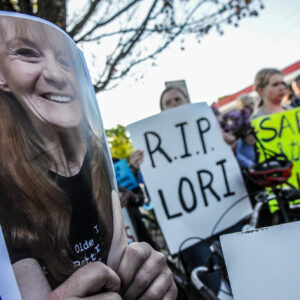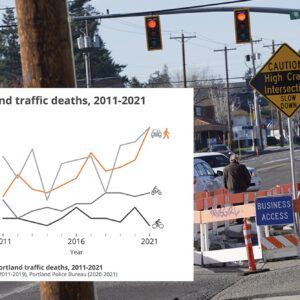Portland’s oft-maligned Vision Zero program will make a trip to City Council next week. The Portland Bureau of Transportation plans to update council members and share their 2023 crash report and Vision Zero Action Plan update.
BikePortland previously reported on the plan update when it was released back in November. But I don’t think we’ve covered the 2023 Deadly Traffic Crash Report, which was finalized in February.
PBOT’s crash report is a summary of where and how people were killed on our streets in 2023. The city’s grim tally of fatalities last year was 69 — the highest death toll in at least three decades and a figure that surpasses 2021’s record high. In the opening of the report, PBOT refers to “those killed by traffic violence” as representing a broad cross-section of Portlanders.
Here are a few stats from the report that caught my eyes:
- East Portland communities face greater exposure to traffic violence. In 2023, East Portland’s traffic death rate per 100,000 was 15 compared to nine in the rest of the city.
- The average age was 40.
- 51 of these traffic victims (74%) as male and 18 (26%) as female.
- In 2023, 74% of traffic deaths occurred on Portland’s High Crash Network.
- Eighty-seven percent of traffic deaths occur on streets with posted speeds of 30 mph and higher. While only 8% of our streets have speed limits higher than 30 mph, 54% of traffic deaths in the last three years have occurred on them.
- Half of the pedestrians who died in 2023 were experiencing houselessness (12 of 24). These statistics speak to the extreme risks of persistent exposure to traffic, often on high-speed streets.
- An average of 16 pedestrians were killed annually between 2018 and 2020, compared to an average of 26 pedestrians in the past three years (2021–2023). But 2023 is the first year that pedestrian deaths are lower. In 2023, pedestrians made up 35% of traffic deaths with 24 pedestrians killed in crashes. In 2021 and 2022, more than 40% of traffic deaths were pedestrians. In 2021, 27 pedestrians died in crashes and 28 died in 2022.
- Black communities in Portland experienced traffic violence at a disproportionate rate when compared to other racial communities in the city. Eleven people killed in traffic crashes were identified as Black, making up 16% of the people killed this year, much higher than their share of Portland’s population (5.6%).
On Wednesday at 2:00 pm PBOT staff will present these findings to council. In the ordinance that will be discussed at the meeting, PBOT shared the ongoing work they’re doing and a few new approaches they’ll take in their fight to eliminate all road deaths by 2025.



One of the new measures was a traffic safety evaluation adjacent to all temporary housing shelters citywide. This analysis will include cost estimates for safety upgrades.
Another new initiative is an executive working group to be convened by the PBOT director. According to the ordinance it will consist of “relevant Bureau directors from across the City,” who will, “Collaborate on actions that support the City’s goal to eliminate traffic deaths.”
In related news, in a Vision Zero newsletter emailed yesterday, PBOT announce a change to their crash response protocol. Launched in 2019 under former PBOT Commissioner Chloe Eudaly, this protocol included the installation of an illuminated message board sign at the location of every fatal crash in the city. The sign would include a date of the crash and the admonition, “Travel With Care.”
Now it appears they will change that program to save money. Instead of putting the signs at all deadly crash locations, PBOT will set out just four signs — one in each of the four new city council districts. The locations will vary each quarter and will focus on intersections that are on the city’s High Crash Network.








Thanks for reading.
BikePortland has served this community with independent community journalism since 2005. We rely on subscriptions from readers like you to survive. Your financial support is vital in keeping this valuable resource alive and well.
Please subscribe today to strengthen and expand our work.
This would be funny if it weren’t so depressing… Vision Zero not having enough funding to even mark where dangerous places are in the city is just outrageous.
[Inhale …. SIGH……..]
Portland should really stop calling it a “Vision Zero” plan. It should really be called:
Portland’s Vaguely Aspirational Plan To Look Like We’re Doing Something about Traffic Deaths While We Continue To Facilitate Unfettered Automobility.
It’s all just tinkering around the edges, moving deck chairs on the Titanic.
If Vision Zero were really A Thing, every single traffic death would REQUIRE a change to prevent another death from occurring.
That’s how aviation has built such a stellar safety record: one plane leaves a runway at Houston and there’s an in-depth investigation followed by enforced changes to ensure the same thing can never happen again.
But that’s not what we do with Vision Zero. The police can’t even investigate crashes properly, as so many people have noted on this site in regard to cycling fatalities.
My advice to City Council: Please stop pretending you have a Vision Zero strategy.
Fred, I think PBOT could legitimately call it the Acceptance of Traffic Violence Plan. The neglected to lower thee speed limit on Greeley when they rebuilt it even though a family was killed there. PBOT just RAISED the speed limit on Naito (money for new signs to encourage faster driving, but no money to pen the close crosswalk or replace missing bollards), and on and on and on. They are actively working AGAINST Vision Zero on most of their projects, even projects done in the name of safety include compromises for pedestrians and bikes in favor of cars (like the bike lane across the pedestrian refuge at 7th/Tillamook to make more space for faster driving).
It’s odd that it is still referred to as vision zero.” To my knowledge, there has never been an effort that was realistically expected to reduce deaths to zero.
It seems like if we want to reduce traffic deaths maybe we should lower the speed limits on those streets.
So PBOT has the data to know what to do: start with lowering the maximum speed on Portland city streets to 25 miles per hour. That’s just a start. Keep nudging away to get to a universal 20 miles per hour.
The next step is enacting meaningful, equitable enforcement of speed limits. A regular driving route for me is NE Halsey from 102nd to 162nd. If you drive 20 on the 20 stretch, or 30 on the 30 stretch, you will inevitably be passed by a large number of cars massively exceeding the speed limits. 30 in the 20 zone and speeds in excess of 45 in the 30 zone are commonplace on these 60 blocks. Driver impunity is in full effect.
And, as noted, the decision to increase the speed on Naito is bizarre and pathetic in a city in the midst of historic numbers of deaths on its’ streets. It’s blatantly nonsensical.
For the past decade, the city council, this mayor, and PBOT have failed to be determined, decisive, or dynamic in making our streets safer for all users. That’s not a political statement; that’s borne out from the lack of direction from City Hall and co., and from the absence of moving-the-needle action that treats a crisis with the appropriate fortitude.
We don’t have to imagine the performative pantomime that will be on display during Wednesday’s meeting. We’ve seen it before from local officials and civil servants. Brows will be furrowed, heads will be mournfully shaken, and mouths will utter words of concern, and, as we’ve come to expect, nothing will meaningful change.
Who do we elect to make changes?
I wouldn’t doubt that anyone who tries to get elected by telling the voters that they want to convert all the streets in Portland to 20 MPH would likely not get enough votes to get into office.
An important parallel to Vision Zero is malaria eradication. After initial failures to easily eradicate malaria worldwide with antimalarial drugs and mosquito control in the 1950-60s, global antimalarial efforts shifted to control. As a result, malaria rates and mortality increased in many areas and it was essentially out of control. After a return to a strategy of eradication, infection and mortality have again decreased, including elimination in many countries. And eradication, is again an imaginable possibility.
Portland needs to admit that it has had the goal of managing or holding transportation-related deaths steady, i.e. “not worse than what the last admin did.” A goal of zero requires strategies that will overshoot the target of zero and do more than is necessary to reach zero. Aiming to slowly creep to zero through incrementalism fails to make any meaningful progress. Officials grasping the basic fundamental importance of vision zero rather than using it as a cheap slogan would be a great first step.
Unfortunately, I think our esteemed friends who work in city government got confused between Vision Zero and zero vision.
Until we realize that traffic enforcement (including police traffic enforcement) is a critical component of reducing traffic violence I’m afraid Vision Zero is doomed in Portland.
Amen. Portland wants it both ways, of course. And it incorrectly beleives it can get there by winning over the hearts & minds of scofflaws with cutesy signs that say “slow the flock down”, lol.
It’s an unrealistic notion based around the myopia of Nü Portland: everyone is here because they want to be here! The realists know that isn’t the case, and a sizable amount of people feel disenfranchised and left out of the Portland that our leaders have envisioned. Why would they give a hoot about “Vision Zero”, some performative yard sign planted by the dual-six-figure-income folks in the gentrified neighborhood of $1M homes? It has no bearing on the lives of so many, yet progressives consistently seem shocked when their good vibes don’t change minds.